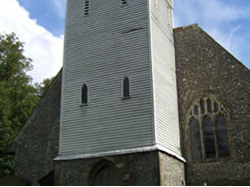Tower, Lectern and Bells
The Tower
the earliest medieval tower at Doddington for which we now have architectural evidence stood to the north of the present tower. It opened into the middle of the nave by a wide, pointed gothic archway that all but spanned the width of the nave, the remains of which are still to be seen in the west nave wall.
Standing on a hillside above the village, Doddington church, and especially the tower, has had little protection from storms through the centuries. Nor is it surprising that the medieval tower was in need of repair as early as 1507, when Andrew Dungate of Downe Court left 3s.4d. "to the raparation (sic) of the Bell Tower" .
Toward the beginning of the Civil War, in the autumn of 1643, occurred probably one of the greatest calamities to befall Doddington church. The steeple on the tower was struck by a "tempest of lightning" and "burnt down", the bells had fallen and lay on the floor "all broken and cracked". The wonder is that the entire church was not destroyed by fire.
The difficulties of rural parishes in raising large sums for repairs are perennial, and the Doddington churchwardens' presentments for the rest of the seventeenth century and beyond tell of the hard struggle to make good the damage. There are no records of anything being done until after the restoration of Charles II in 1660. At the Archdeacon's court in 1664 Doddington churchwardens Edward Gurney and Robert Peckenham stated that it was "true" that the steeple was "ruined" and explained that "the parishioners are not of ability to repair the same, it being almost twenty two years since it happened, whereby the work will be very chargeable, insomuch that half the rent of the land in the parish will not be sufficient to do it".
In the first part of the eighteenth century the medieval tower was at last repaired, and a steeple erected, for Edward Hasted wrote in his 'History of Kent' 1782 that at Doddington church "At the west end is a low, pointed steeple in which hang six bells".
At the beginning of the nineteenth century, however, the tower, no doubt having been found to be unsafe, was taken down. It was replaced cheaply by a smaller, lower, and wooden weather boarded structure with wooden battlements on top and standing on a stone base somewhat to the southward of the medieval tower. The expense was met by selling four of the six bells mentioned by Hasted.
The Lecturn
With brass inscription at base :
"To the Glory of God, and in affectionate remembrance of the men in our village who gave their lives for their country 1914 - 1918
Presented by the Members of the Doddington Mothers Union 1918 Names of the Fallen
Wilfred Carryer
James Davis
Percy Sorscer
Leonard Jarvis
Harry Philpot
Sidney Kite
Frank Mills
Sydney Pullen
William Seager
Richard Smith
Frederick Mungeam "
The Bells
Dungate's will of 1507 is the first we hear of the medieval bells in Doddington's tower. Later accounts of them in churchwarden's presentments show that there were four and that their combined weight was estimated at about "forty hundredweight" (Presentments of 1560, vol.1560-84 Fol.38)
Although in 1664 the judge advised the churchwardens to send out a "brief" to other parishes asking for contributions for repair of the Doddington steeple and bells " ...and for a flagon for the communion which they say is yet wanting...." again in 1678 Doddington protested that "the parish is not able to repair the steeple and mend the bells and hang them as required..." The parish was finally driven to selling the ruined medieval bells for bell-metal, for which the Vicar himself, Daniel Somerscales, petitioned the court in person on May 24th 1695, which was granted. In May 1698 churchwarden William Skeene reported that the bells had been sold for £77 17s.6d. but still the matter dragged on. On October 9th 1701 the parishioners agreed that "£3 be yearly made up and placed for the increase of a sum for new bells"
When J.C.L. Stahlschmidt wrote his 'Church Bells of Kent' in 1887, there were still only two bells at Doddington church, both of the eighteenth century, and but one of them, according to the Vicar, Ref. W.J. Monk, "in ringing order". Stahlschmidt listed them as :
"I.,31-in ROBERT CATLIN FECIT 1751
II.,33-IN. RICHARD PHELPS MADE ME 1712"
The second bell now bears the following additional inscription:
"RE CAST 1962
CHRISTOPHER VEAZEY VICAR
CHARLES LEESE CMG
CHURCHWARDEN CYRIL SMITH"

